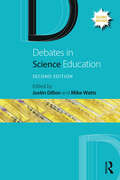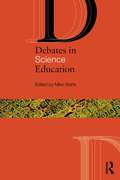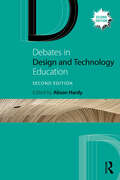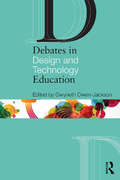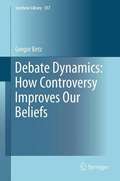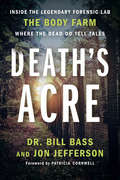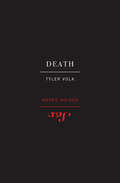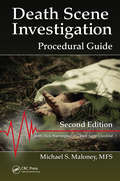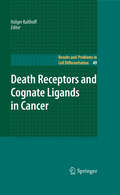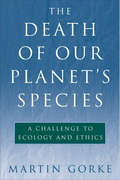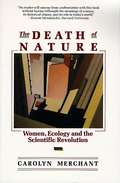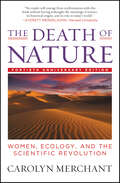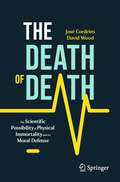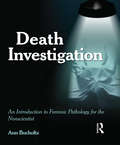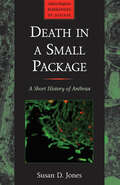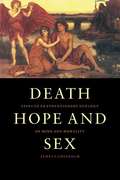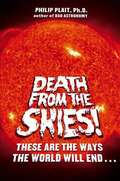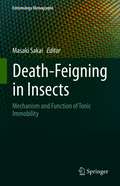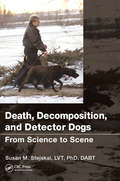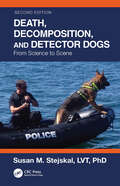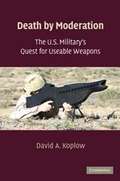- Table View
- List View
Debates in Science Education (Debates in Subject Teaching)
by Justin Dillon Mike WattsThis fully revised second edition of Debates in Science Education explores the major issues that science teachers encounter in teaching their subject, encouraging the reader to make their own informed judgements and argue their point of view with deeper theoretical knowledge and understanding. Brand new chapters written by a team of international experts provide fresh insight into topics of central importance when teaching science. Written to aid and inspire beginning teachers, current teachers and established subject leaders, these focused chapters are essential to anyone wishing to deepen their understanding of salient issues within school science education, including: STEAM education; sustainability and climate change; science and sensitive issues; equity and diversity; science and sex education; science and religion; science and pedagogy (including science inquiry); transition from primary to secondary school. Encouraging critical reflection and aiming to stimulate both novice and experienced teachers, this book is a valuable resource for any student or practicing teacher and particularly those engaged in continuing professional development or Master’s level study.
Debates in Science Education (Debates in Subject Teaching)
by Mike WattsWhat are the key debates in science teaching and learning today? Debates in Science Education explores the major issues all science teachers encounter in their daily professional lives. It encourages critical reflection and aims to stimulate both novice and experienced teachers to think more deeply about their practice, and link research and evidence to what they have observed in schools. Written by expert science educators, chapters tackle established and contemporary issues enabling you to reach informed judgements and argue your point of view with deeper theoretical knowledge and understanding. Each chapter is supported and extended by carefully selected further reading and reflective questions. Key debates include: the impact of policy on science education; transition from primary to secondary school; getting right the secondary science curriculum; girls in science; sex education and science; school science and technology; language and communication in the classroom; world science, local science. With its combination of expert opinion and fresh insight, Debates in Science Education is the ideal companion for any student or practising teacher engaged in initial training, continuing professional development and Masters level study.
Debates in Design and Technology Education (Debates in Subject Teaching)
by Alison HardyDesign and technology is a relatively new subject compared to more traditional subjects, and during its brief existence, it has garnered widespread debate in schools. This book aims to explore some of these debates and challenges the reader with new perspectives about the subject by presenting and questioning arguments about the purpose, content and place of design and technology in the school curriculum. It will encourage the reader to critically reflect on their own beliefs and practices to reach informed judgements and perspectives that will affect how they teach and think about design and technology. Exploring the major issues that design and technology teachers encounter in their professional lives as well as introducing new topics they may never have considered before, this comprehensive second edition has been fully updated with 16 chapters focusing on emerging and enduring debates: How do we do race in design and technology? What’s so special about design and technology anyway? What is design cognition in design and technology classrooms? What is the potential of feedback in the creative processes of a design and technology classroom? Does food fit in design and technology? What is the role of making in design and technology? With its combination of expert opinion and fresh insight, Debates in Design and Technology Education is the ideal companion for any student or practising teacher engaged in initial training, continuing professional development or master’s-level study.
Debates in Design and Technology Education (Debates in Subject Teaching)
by Gwyneth Owen-JacksonDesign and Technology has long held a controversial place on the school curriculum, with some arguing that it shouldn’t be there at all. This book presents and questions considered arguments and judgements, and explores the major issues that all D&T teachers encounter in their daily professional lives. In exploring some of the key debates, it encourages critical reflection and aims to stimulate both novice and experienced teachers to think more deeply about their practice, and link research and evidence to what they have observed in schools. Written by expert design and technology education professionals, chapters tackle established and contemporary issues, enabling you to reach informed judgements and argue your point of view with deeper theoretical knowledge and understanding. Debates covered include: What is the purpose of design and technology? Is it a vocational or academic subject? What is the place of design and technology within the STEM agenda? What knowledge and skills do teachers really need? What does the design and technology gender divide mean for schools and pupils? Is it a ‘creative’ subject? What is the future for design and technology? With its combination of expert opinion and fresh insight, Debates in Design and Technology Education is the ideal companion for any student or practising teacher engaged in initial training, continuing professional development or Masters level study.
Debate Dynamics: How Controversy Improves Our Beliefs (Synthese Library #357)
by Gregor BetzIs critical argumentation an effective way to overcome disagreement? And does the exchange of arguments bring opponents in a controversy closer to the truth? This study provides a new perspective on these pivotal questions. By means of multi-agent simulations, it investigates the truth and consensus-conduciveness of controversial debates. The book brings together research in formal epistemology and argumentation theory. Aside from its consequences for discursive practice, the work may have important implications for philosophy of science and the way we construe scientific rationality as well.
Debate Dynamics: How Controversy Improves Our Beliefs
by Gregor BetzIs critical argumentation an effective way to overcome disagreement? And does the exchange of arguments bring opponents in a controversy closer to the truth? This study provides a new perspective on these pivotal questions. By means of multi-agent simulations, it investigates the truth and consensus-conduciveness of controversial debates. The book brings together research in formal epistemology and argumentation theory. Aside from its consequences for discursive practice, the work may have important implications for philosophy of science and the way we construe scientific rationality as well.
Death's Acre: Inside the Legendary Forensic Lab the Body Farm Where the Dead Do Tell Tales
by Jon Jefferson William BassDr. Bill Bass, one of the world's leading forensic anthropologists, gained international attention when he built a forensic lab like no other: The Body Farm. Now, this master scientist unlocks the gates of his lab to reveal his most intriguing cases-and to revisit the Lindbergh kidnapping and murder, fifty years after the fact.
Death Valley Rocks & Minerals (Destinations In Science)
by David C. BrummettDeath Valley impresses more than a million visitors each year, and anyone with a feeling for geology surely considers it a choice destination. It is a vast showcase of rocks and landforms, testifying to geologic events over billions of years. And most compelling for specialists, Death Valley displays the evidence and effects of extreme crustal extension, revealing the rarely seen doings of the deep crust in a setting where the faults and rocks are exposed in extraordinary detail.
Death & Sex
by Tyler Volk Dorion SaganWhat is shared by spawning Pacific salmon, towering trees, and suicidal bacteria? In his lucid and concise exploration of how and why things die, Tyler Volk explains the intriguing ways creatures-including ourselves-use death to actually enhance life. The exquisite schemes and styles of death that have emerged from evolution have been essential to the great story from life's beginnings in tiny bacteria to ancient human rituals surrounding death and continuing to the existential concerns of human culture and consciousness today. Volk weaves together autobiography, biology, Earth history, and results of fascinating studies that show how thoughts of our own mortality affect our everyday lives, to prove how an understanding of what some have called the ultimate taboo can enrich the celebration of life. In Sex, Dorion Sagan takes a delightful, irreverent, and informative romp through the science, philosophy, and literature of humanity's most obsessive subject. Linking evolutionary biology to salacious readings of the lives and thoughts of such notables as the Marquis de Sade and Simone de Beauvoir, and discussing works as varied as The Story of O and Silence of the Lambs, Sex touches on a potpourri of interrelated topics ranging from animal genitalia to sperm competition, the difference between nakedness and nudity, jealousy's status as an aphrodisiac and the origins of language, Casanova and music, ovulation and clothes, mother-in-law jokes and alpha females, love and loneliness. Two books in one cover, Death & Sex unravel and answer some of life's most fundamental questions.
Death Scenes
by Sean Tejaratchi Dunn KatherineThe strange and gruesome crime-scene snapshot collection of LAPD detective Jack Huddleston spans Southern California in its noir heyday. Death Scenes is the noted forerunner of several copycat titles.
Death Scene Investigation: Procedural Guide, Second Edition
by Michael S. MaloneyThose tasked with investigating death scenes come from a variety of backgrounds and varying levels of experience. Whether a homicide detective, crime scene investigator, medico-legal death investigator, coroner or medical examiner, Death Scene Investigation: Procedural Guide, Second Edition provides the investigator best-practice techniques and procedures for almost any death scene imaginable, including for deaths occurring even under the most unusual of circumstances. This Second Edition is fully updated to include new coverage on shallow graves, human remains at crime scenes, poisonings, expanded coverage of projectile weapons, videography, touch DNA, death notifications, and a newly added chapter dedicated to sexual deaths. In addition, the book serves as an on-scene ready reference which includes instructions on procedure including the initial notification of a death, processing the scene and body, the investigator's role at autopsy, and analyzing the scene indicators to place evidence into context. Topics discussed include: Initial response and scene evaluation Death scene management including documentation, sketching, photography, videography, observations, and search procedures A special death investigation matrix that walks the investigator though a decision tree to help in ambiguous deaths Contains discussion of all manners of death, including accident, suicide, natural and homicide Coverage of recovery of human remains from open field, aquatic, and buried sites including estimating the time of death. Wound dynamics and mechanisms of injury that covers asphyxiation, sharp and blunt force trauma, chopping injuries; handgun, rifle, and shotgun wounds, electrical injuries, and more The bulleted format and spiral binding allows for easy use and reference in the field with sections that are self-contained and cross-referenced for quick searches. With its thorough and detailed approach, Death Scene Investigation, Second Edition will be a must-have addition to any crime scene and death investigator’s tool kit.
Death Receptors and Cognate Ligands in Cancer
by Holger KalthoffDeath receptors play a central role in directing apoptosis in mammalian cells. This process of active cell death is important for a number of biological processes, e.g. for the regulation of the immune system. Death receptors are cell surface receptors that transmit apoptotic signals initiated by corresponding death ligands. Many complex signaling pathways are activated and apoptosis is the final result of a complex biochemical cascade of events. Besides their role in the induction of cell death, evidence now exists that death receptors are able to activate several non-apoptotic signaling pathways which, depending on cellular context, may lead to apoptosis resistance, secretion of pro-inflammatory proteins, proliferation and invasive growth of cancer cells. This book looks at the molecular basis of death receptor signaling and the role of death receptors in cancer development.
The Death of Our Planet's Species: A Challenge To Ecology And Ethics
by Martin GorkeThe present rate and extent of species extinction -- estimated by some scientists as one species every 20 minutes -- are unprecedented in the history of mankind. Human activities are responsible for nearly all species loss, yet ethical aspects of this crisis are rarely mentioned. Any concern expressed tends to be over potentially valuable resources -- information for scientists, or compounds that could be used in new medicines -- that are lost when a species disappears.In The Death of Our Planet's Species, Martin Gorke argues that such a utilitarian perspective is not only shortsighted but morally bankrupt. Holding doctoral degrees in both ecology and philosophy, Gorke is uniquely qualified to examine the extinction crisis from both scientific and philosophical perspectives. He offers a wide-ranging review of the literature on the subject, drawing together those two lines of reasoning that are almost always pursued separately.After critical examination of the current state of relevant ecological knowledge, Gorke presents a carefully considered case for attributing intrinsic value to all of nature, including all species. At the heart of his argument is an analysis of the concept of morality. According to this analysis, the universal character of morality does not permit us to establish limits of moral considerability. More precisely, every act of exclusion from the moral community is an arbitrary act and is not compatible with a moral point of view.The Death of Our Planet's Species sets forth a sound and original argument about the philosophical and ethical dimensions of species conservation. Throughout, the author combines a high level of theoretical sophistication with clear and straightforward writing. Orignially published in German, this Island Press edition makes The Death of Our Planet's Species available for the first time to English-speaking experts and lay readers.
The Death of Nature: Women, Ecology and the Scientific Revolution
by Carolyn MerchantHow the scientific revolution sanctioned the exploitation of nature, commercial expansion, and the subjugation of women.
The Death of Nature: Women, Ecology, and the Scientific Revolution
by Carolyn MerchantUPDATED 40TH ANNIVERSARY EDITION WITH 2020 PREFACEAn examination of the Scientific Revolution that shows how the mechanistic world view of modern science has sanctioned the exploitation of nature, unrestrained commercial expansion, and a new socioeconomic order that subordinates women.
The Death of Death: The Scientific Possibility of Physical Immortality and its Moral Defense (Copernicus Books)
by José Cordeiro David WoodIs death inevitable? Until now, the history of mankind has been marked by this fatal fact. Religions, borders and progress are born from an ancient fear of death, comfort from this fear man often found only in religious paradigms. But according to José Luis Cordeiro and David Wood, the incontrovertible fact of death is no longer an absolute certainty - science and technology are preparing to tear down the final frontier: that of immortality.This accessible book provides insight into recent exponential advances in artificial intelligence, tissue regeneration, stem cell treatment, organ printing, cryopreservation, and genetic therapies that, for the first time in human history, offer a realistic chance to solve the problem of the aging of the human body. In this book, Cordeiro and Wood not only present all the major developments, initiatives, and ideas for eternal life, they also show why there are a number of good arguments for seeing death for what it is: the last undefeated disease.Enter any drugstore or bookstore, and we confronted with a mountain of nonsense concerning the aging process. Society seems obsessed with aging. That is why The Death of Death is such a refreshing delight, able to cut through the hype and reveal a balanced, authoritative, and lucid discussion of this controversial topic. It summarizes the astonishing breakthroughs made recently in revealing how science may one day conquer the aging process.Michio Kaku, theoretical physicist and author of The God Equation: The Quest for a Theory of Everything We are entering a Fantastic Voyage into life extension, crossing different bridges that will take us to indefinite life spans. The Death of Death explains clearly how we might soon reach longevity escape velocity and live long enough to live forever. Ray Kurzweil, co-author of Fantastic Voyage: Live Long Enough to Live Forever and co-founder of Singularity University The Death of Death is a truly revolutionary book. This is a visionary book that confronts us with the terrible reality of aging, and its authors are friends and connoisseurs of the subject. I believe that the authoritative and exhaustive description of this crusade that José and David make in this excellent book will accelerate this process. Forward! Aubrey de Grey, founder of LEV (Longevity Escape Velocity) Foundation and co-author of Ending Aging
Death Investigation: An Introduction to Forensic Pathology for the Nonscientist
by Ann BucholtzDeath Investigation: An Introduction to Forensic Pathology for the Nonscientist provides students and law enforcement professionals with an accurate, clear overview of forensic pathology. It presents death investigation at the scene and autopsy, providing readers with a broad understanding of forensic pathology and giving them a clear picture of what happens after the examination of the scene. Readers learn what first responders should (and should not) do at the scene, and get a forensic pathologist's perspective on the importance of preserving evidence. Death Investigation methodically explains what happens during autopsy to determine cause and manner of death -- including particulars of blunt force trauma, sharp force injuries, asphyxia, and gunshot wounds -- and how findings are presented in court. Written for a criminal justice audience by a practicing forensic pathologist and educator, Death Investigation makes challenging forensics concepts accessible to nonscientists.
Death in a Small Package: A Short History of Anthrax (Johns Hopkins Biographies of Disease)
by Susan D. JonesA look at the historical development of the lethal disease and its relationship with humanity.A disease of soil, animals, and people, anthrax has threatened lives for at least two thousand years. Farmers have long recognized its lasting virulence, but in our time, anthrax has been associated with terrorism and warfare. What accounts for this frightening transformation? Death in a Small Package recounts how this ubiquitous agricultural disease came to be one of the deadliest and most feared biological weapons in the world.Bacillus anthracis is lethal. Animals killed by the disease are buried deep underground, where anthrax spores remain viable for decades or even centuries and, if accidentally disturbed, can cause new infections. But anthrax can be deliberately aerosolized and used to kill—as it was in the United States in 2001.Historian and veterinarian Susan D. Jones recounts the life story of anthrax through the biology of the bacillus; the political, economic, geographic, and scientific factors that affect anthrax prevalence; and the cultural beliefs about the disease that have shaped human responses to it. She explains how Bacillus anthracis became domesticated, discusses what researchers have learned from numerous outbreaks, and analyzes how the bacillus came to be weaponized and what this development means for the modern world.Jones compellingly narrates the biography of this frightfully hardy disease from the ancient world through the present day.“Death in a Small Package is interesting, well written, and accessible, presenting a worthwhile addition to the history of modern medicine and bacteriological science.” —Karen Brown, Isis
Death in a Small Package: A Short History of Anthrax (Johns Hopkins Biographies of Disease)
by Susan D. JonesA disease of soil, animals, and people, anthrax has threatened lives for at least two thousand years. Farmers have long recognized its lasting virulence, but in our time, anthrax has been associated with terrorism and warfare. What accounts for this frightening transformation? Death in a Small Package recounts how this ubiquitous agricultural disease came to be one of the deadliest and most feared biological weapons in the world.Bacillus anthracis is lethal. Animals killed by the disease are buried deep underground, where anthrax spores remain viable for decades or even centuries and, if accidentally disturbed, can cause new infections. But anthrax can be deliberately aerosolized and used to kill—as it was in the United States in 2001. Historian and veterinarian Susan D. Jones recounts the life story of anthrax through the biology of the bacillus; the political, economic, geographic, and scientific factors that affect anthrax prevalance; and the cultural beliefs about the disease that have shaped human responses to it. She explains how Bacillus anthracis became domesticated, discusses what researchers have learned from numerous outbreaks, and analyzes how the bacillus came to be weaponized and what this development means for the modern world.Jones compellingly narrates the biography of this frightfully hardy disease from the ancient world through the present day.
Death, Hope And Sex: Steps To An Evolutionary Ecology Of Mind And Morality
by James S. ChisholmBy showing how and why human nature is what it is, evolutionary theory can help us see better what we need to do to improve the human condition. Following evolutionary theory to its logical conclusion, Death, Hope and Sex uses life history theory and attachment theory to construct a model of human nature in which critical features are understood in terms of the development of alternative reproductive strategies contingent on environmental risk and uncertainty. James Chisholm examines the implications of this model for perspectives on concerns associated with human reproduction, including teen pregnancy, and young male violence. He thus develops new approaches for thorny issues such as the nature-nurture and mind-body dichotomies. Bridging the gap between the social and biological sciences, this far-reaching volume will be a source of inspiration, debate and discussion for all those interested in the evolution of human nature and the potential for an evolutionary humanism.
Death from the Skies! These Are the Ways the World Will End
by Plait PhilipA lively astronomy primer that uses cataclysmic scenarios to explain the universe's most fascinating events. According to astronomer Philip Plait, the universe is an apocalypse waiting to happen But how much do we really need to fear from things like black holes, gamma-ray bursts, and supernovae? And if we should be scared, is there anything we can do to save ourselves? With humor and wit, Plait details the myriad doomsday events that the cosmos could send our way to destroy our planet and life as we know it. This authoritative yet accessible study is the ultimate astronomy lesson. Combining fascinating?and often alarming?scenarios that seem plucked from science fiction with the latest research and opinions, Plait illustrates why outer space is not as remote as most people think. Each chapter explores a different phenomenon, explaining it in easy-to-understand terms, and considering how life on earth and the planet itself would be affected should the event come to pass. Rather than sensationalizing the information, Plait analyzes the probability of these catastrophes occurring in our lifetimes and what we can do to stop them. With its entertaining tone and enlightening explanation of unfathomable concepts, Death from the Skies! will appeal to science buffs and beginners alike. .
Death-Feigning in Insects: Mechanism and Function of Tonic Immobility (Entomology Monographs)
by Masaki SakaiThis book examines the mechanisms and functions of tonic immobility, the so-called death feigning behavior, or thanatosis, or animal hypnosis. The chapters cover the neurophysiological and experimental studies on insects, the functional significance of death-feigning, examination of the freezing and immobility behavior in insects through environment, physiology, genetics, and responses to ultrasound and vibration. It also covers tonic immobility and freezing behavior in fish from the perspective of vertebrates study.Tonic immobility is an interesting behavior that occurs reflexively in various animals under physical restraint by predators. The physiological mechanism of thanatosis was extensively investigated during 1960-1980. Researchers have proposed hypotheses to explain the mechanism underlying tonic immobility in vertebrates; local inhibition of the central nervous system, acceleration of the limbic system, abnormal control of the autonomic nervous system. On the other hand, the peripheral and central mechanisms of tonic immobility were intensely investigated at a behavioral and a neuronal level in stick insects and crickets. In the 1970s, behavioral ecology has shed light on the aspect of an ultimate factor for tonic immobility. Ethologists and ecologists challenged this matter in the laboratory and natural habitats, and have collected evidence for its functional roles using mainly insects such as beetles, moths, locusts. More recently, studies of tonic immobility in humans are drawing attention, as clinicians are trying to explain the defencelessness of rape victims from the viewpoint of animal hypnosis.This timely publication provides an understanding of the past and present research of the mechanisms and functions of tonic immobility. This book is intended for researchers and undergraduate/ graduate students in the field of zoology including physiology, ethology, ecology, and human behavior. It will also appeal to the public audience who has an interest in animal behavior, including human behavior.
Death, Decomposition, and Detector Dogs: From Science to Scene
by Susan M. StejskalDeath, Decomposition, and Detector Dogs: From Science to Scene is designed to help police investigators and Human Remains Detection K9 handlers understand the basics of forensic taphonomy (decomposition) and how to most effectively use a human remains detection (HRD) K9 as a locating tool. The book covers basic anatomy and the physiology of canine
Death, Decomposition, and Detector Dogs: From Science to Scene
by Susan M. StejskalDeath, Decomposition, and Detector Dogs: From Science to Scene, Second Edition is designed to help canine handlers, detectives, death investigators, crime scene personnel (including forensic laboratory personnel, technicians, and supervisors), and attorneys understand the science involved when utilizing human remains detector (HRD) canines as a locating tool. The book covers the basic anatomy and physiology of canine olfaction and the unique characteristics of their scenting ability that allows dogs to be trained to locate distinct odors. Using concise and clear explanations and photographs, the book reviews the science of forensic taphonomy. Factors that may affect the decomposition process are highlighted along with what the potential outcomes that may be encountered. The book examines how the odor of human remains is generated through various stages of decomposition and the manner in which environmental conditions in both land and water settings may affect that odor. Different types of background information that may help in determining possible search locations for missing individuals are included as well as assist the HRD canine handler in developing search plans are covered. Different tools and technologies that may be used in addition to an HRD canine team are included to help readers understand that are many ways to address searching for a decedent. Several case reports involving decedents, found in both land and water settings in addition to different weather conditions, are included to help the reader understand how the environment may have affected the condition of the decedent. This edition includes more case reports explaining how environmental factors were considered in HRD canine deployments in both land and water settings. Understanding which variables—and how such variables—can affect the state and condition of human remains, as well as dispersion of odor from human remains, will help canine handlers utilize their HRD canine more effectively as a locating tool. Death, Decomposition, and Detector Dogs, Second Edition will help HRD canine handlers and other law enforcement personnel be better prepared to meet the challenges of their jobs before, during, and after searches for the missing.
Death by Moderation: The U. S. Military's Quest for Useable Weapons
by David A. KoplowThis book addresses an important but little-noticed phenomenon in the revolutionary world of military technology. Across a wide range of otherwise-unrelated weapons programs, the Pentagon is now pursuing arms that are deliberately crafted to be less powerful, less deadly, and less destructive than the systems they are designed to supplement or replace. This direction is historically anomalous; military forces generally pursue ever-bigger bangs, but the modern conditions of counter-insurgency warfare and military operations "other than war" (such as peacekeeping and humanitarian assistance) demand a military capable of modulated force. By providing a capacity to intervene deftly yet effectively, the new generations of "useable" weaponry should enable the U.S. military to accomplish its demanding missions in a manner consistent with legal obligations, public relations realities, and political constraints. Five case studies are provided, regarding precision-guided "smart bombs," low-yield nuclear weapons, self-neutralizing anti-personnel land mines, directed-energy anti-satellite weapons, and non-lethal weapons.
